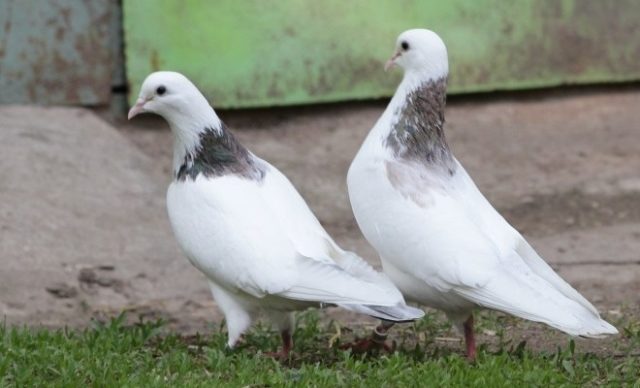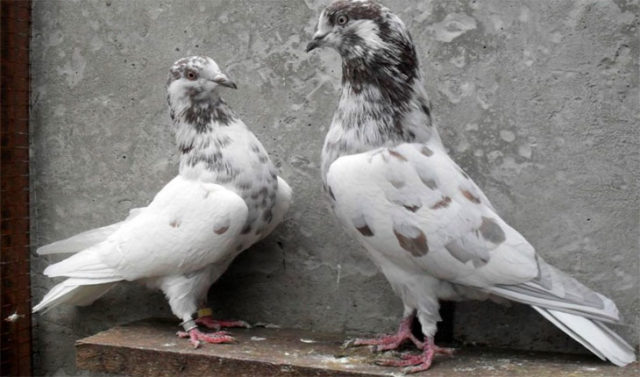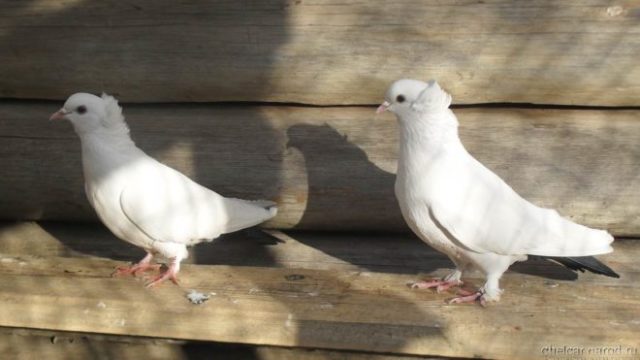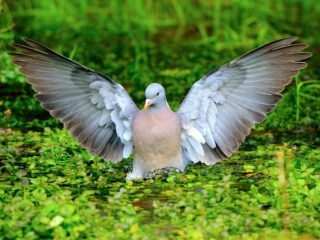Content
Baku pigeons are a fighting breed bred in Azerbaijan at the beginning of the 18th century. The city of Baku became the breeding center for the first representatives.
Many are initially misled by the word “fighting” in the name of this variety. It implies that birds, when taking off, make characteristic flapping sounds of their wings, reminiscent of clicks - this is what is called “fighting”. This is one of the main characteristics of Baku pigeons, along with summer and flight duration. The appearance of the birds and color were not particularly important in Azerbaijan, although ultimately the new species still split into many subspecies with different colors and types of plumage.
History of Baku pigeons
The first mentions of Baku pigeons date back to the 18th century, when records were made in Iranian sources - then the territory of modern Azerbaijan was under the control of Persia.In the mid-20th century, Baku residents were brought to Russia.
Of course, since then the Baku breed has undergone some changes in the course of breeding work. In some subspecies, the forelocks became more noticeable, the feathery “boots” on the legs disappeared, and the physique became lighter. In addition, in our time the breed is represented by a wide variety of colors, although initially the Bakuvians had several color options.
Years of Baku pigeons
Despite the variety of colors and types of plumage, Baku breeds have a number of common features that make them stand out from other breeds, including fighting breeds. First of all, these are the birds' high altitude, flight duration and unique fighting style.
Baku residents fly high, sometimes out of sight, and are able to stay in the air for a long time. Moreover, in terms of flight duration, Baku pigeons are considered record holders - if the birds are trained correctly, their flight will be 5-12 hours, and all this time it will be accompanied by good play. The quality of the game is assessed by how the pigeon enters the post - the bird makes at least 3 somersaults with clapping.
Baku pigeons have three types of fighting.
- Exit to the pillar. A type of game in which a pigeon rises into the air almost vertically, after which it abruptly somersaults, throwing its head back. This somersault is accompanied by a loud flapping of wings. The height of the exit is 12-15 meters; as it rises, the pigeon makes an average of 5-6 somersaults, actively flapping its wings. For trained Baku residents this figure is even higher.
- Post with screw. This type of combat is characterized by a shuttle move, but the execution of a somersault is also accompanied by a click.
- Zavis fight. The game is characterized by a slow pace of flight and a relaxed combat pattern. Every now and then the dove seems to hover in the air, turning over from time to time, after which it rises higher. Somersaults are relatively slow, but even with this style they are accompanied by a pop.
The years of Baku residents are shown in the video, where pigeons demonstrate elements of combat:
Breed characteristics and standards
The standard for fighting pigeons of the Baku breed requires compliance with the following characteristics:
- strong physique;
- medium sized pigeon;
- the plumage is dense, thick, there may be a forelock or “eyebrows” on the head;
- on the chest and neck there is a purple tint, noticeable on all color types;
- the head is elongated, with smooth plumage or forelock;
- forehead is rounded;
- crown flattened, rectangular;
- the beak is straight and thin, slightly curved downwards at the end;
- beak color white
- the cere is poorly developed, smooth to the touch and white;
- the neck is not long, but not short either, slightly curved;
- broad shoulders;
- the back is long, descending towards the tail;
- Baku residents have an elongated silhouette;
- the wings are long, lying at their ends on the tail;
- the plumage of the wings is pressed tightly against the body of the Baku residents;
- tail of a closed type, consisting of 14-16 tail feathers;
- legs are bare or dressed in feather “boots”;
- the color of the legs in various shades of red;
- claws are light, almost white.
Pillar Baku birds have some disadvantages - the lack of a bend in the neck or the roundness of the crown, however, a number of characteristics in a pigeon are unacceptable:
- heterochromia (different eye colors);
- feathering on fingers;
- shortened torso;
- excessively protruding chest;
- drooping wings;
- the tail sags, touching the ground;
- the beak is too short and thick;
- hump on the back;
- neck too thick;
- the plumage is loose.
What kind of Baku pigeons are there by color?
Baku pigeons are distinguished by a wide variety of colors. There are birds with a single color (black, white, yellowish-brown), variegated (marbled), two-colored (white with a black or red tail, white with a “neck”), gray, bronze with splashes, etc. Among this variety are pigeons with smooth plumage, Baku pigeons with forelocks and a variety with pronounced “eyebrows”, which is also sometimes called gloomy.
Subspecies of the Baku breed of fighting pigeons are shown in the photo.
White Baku fighting pigeons
Baku pigeons of exclusively white color are highly valued at exhibitions. As a rule, they do not have a forelock; their heads are smooth. Feathering on the legs is also absent in most cases, but there are specimens with “boots.” The skin on the feet of white Baku residents is red, but the claws of pigeons are lighter.
The body of white Baku pigeons is graceful, slightly elongated.
Baku pigeons with a “neck”
Baku pigeons with a “neck” are also called grivuns. They received this name for the peculiarity of their plumage - their body is mostly light, colored white, beige or milky; there is a spot on the back of the neck, which partially extends onto the sides. The color of the spot is black, brown, reddish or yellow. Sometimes the tail feathers are painted the same color.
Regardless of the color, the “neck” of the Baku pigeons has a bluish tint, due to which the pigeons’ plumage shimmers even in low light.
The flight abilities of birds with a “neck” are no different from most other species; they are classified into a separate group solely based on their appearance.
Marbled pigeons from Baku
Marbled Baku pigeons are usually light in color, but interspersed with dark tones. The main color is white, light gray or milky, sometimes darker shades are found. The spots on the body and head are black, dark gray or brown.
The peculiarity of this subspecies is that the color of the plumage changes as the bird grows older. With each molt, the color of the feathers becomes richer. Marbled Bakuvians do not have a forelock, but its presence is not a disqualifying feature.
Mirror pigeons from Baku
Mirror Baku pigeons can be of almost any color, but none of them are monochromatic. The name of this variety of Baku birds is based on the mirror-symmetrical pattern on the wings and tail of the birds. According to the type of plumage, mirror Baku pigeons are smooth, without forelocks and “eyebrows”.
Red and white pigeons from Baku
This is not a separate breed, but a color variant. This color variant is found in black-tailed Baku pigeons, whose plumage is represented by a white base and a black tail. Sometimes red-tailed Bakuns are also found in this species; otherwise, the pigeons are no different from their relatives in appearance.
Yellow pigeons from Baku
Yellow plumage in its pure form is found only in Baku bronze pigeons, while the feathers have a reddish tint in the sun. Sometimes black spots are scattered across the body of Baku residents.
There are also Baku residents with yellow spots among hryvnias or pigeons with “necks”.
Black pigeons from Baku
Black Baku pigeons, like red and white ones, are not classified as a separate breed. This color is found in many varieties, but more often black plumage is present in chili pigeons. But it is difficult to call it monochromatic - on the neck and chest of black Bakuvians there are bluish spots that cast a greenish tint in the sun.
Baku chili pigeons
Chili or colored Baku pigeons are a motley fighting breed. The subspecies is distinguished by dense and dense plumage, including on the legs. The chest is wider than that of other Bakuvians, the body is elongated. The eyes are light, but more often yellow in color. The beak is straight and does not bend towards the bottom. There is often a pronounced forelock on the head, but “eyebrows” are practically never found.
The color scheme of Baku chili pigeons implies relatively uniform plumage on the body and wings and a variegated head and neck. Color combinations can be very different: black color with white splashes, light base and red spots, milky body and brown head, etc. On the chest and neck of the Baku Chili there is a bluish spot that has a purple tint in the sun. Secondary foci of variegation are on the tail and wings, but the bulk is concentrated on the head and neck. The brushes on the legs match the color of the bird's main color.
The behavioral difference of this breed of Baku pigeons is their love for long, solitary flights. During such flights they often go into a “pillar”.In addition, Baku Chili often do unexpected somersaults.
Other varieties of Baku pigeons
In addition to these, there are many small varieties of fighting pigeons. Of interest among them are the broad-tailed or multi-feathered Baku pigeons, the high-flying and fighting Agbash breed.
Broad-tailed Bakuns are a subspecies of pigeons that are among the hardiest. They are able to spend 10-15 hours in the air, and this is not the limit. The birds' musculature is well developed, they have a fairly powerful physique, but at the same time they remain an outwardly attractive breed. The color of the broad-tailed Baku residents is very diverse. Typical tones are white, ash and milky without inclusions.
Broad-tailed Baku pigeons got their name from the structural features of their tail. When spread out, it is similar to the tails of peacock pigeons.
High-flying individuals do not stand out much from the background of other Baku breeds. The only difference is the high flight. The coloration of high-flying pigeons can be very different.
The Agbash breed differs from other varieties in its adaptive abilities. The color of the Baku Agbash is monochromatic, most often white, but there is also a color scheme in which the bird’s body is dark and the head is light. Specimens with lush forelocks are common among representatives of the breed.
The legs of the Baku Agbash breed are bare, sometimes with feathers.
Breeding Baku pigeons
Baku pigeons are an extremely unpretentious breed that adapts to different living conditions. The doves sit well on the clutch and feed the chicks without any problems.For this reason, poultry farmers use them as feeders. Bakuvians rarely fly away - they are monogamous and strongly attached to home.
The advantages of the breed also include fast learning. Birds learn the basics of training in the shortest possible time if they are carried out correctly and do not miss classes. It is important to remember that each individual is individual. Baku residents study different elements of fighting at different times; you should not expect the same results from all birds.
A special feature of the breed is that females are able to lay eggs throughout the year. If this is not desirable for the poultry farmer, items that females use to build a nest are removed from the enclosure.
Feeding Baku pigeons
It is widely believed that it is better to slightly underfeed Baku pigeons and keep them on a strict diet. It is believed that this way the birds become more docile and listen better to the owner, but this statement is not supported by facts. Therefore, poultry farmers prefer to feed Baku residents fully, but they agree on one thing - excess nutrition harms the birds. Birds should not be overfed.
Baku residents are fed according to a schedule from the first days of life. This has a beneficial effect on the condition of the birds' crop - it does not stretch, but at the same time it is not empty. The chicks are fed soft foods, with an emphasis on the daily meal, which occurs at noon.
The following products are suitable for feeding Baku pigeons:
- Millet. This is the basis of food for Baku residents.When choosing food, you should pay attention to formulations with grains of rich color - they have a particularly high concentration of vitamins and beneficial microelements.
- Wheat. Together with millet, this crop forms the basis of the diet of Baku pigeons, but it is low in calcium. If you focus on wheat at the expense of millet feed, you will have to additionally feed the birds with mineral supplements.
- Oats. The culture is well digestible, but it contains a lot of husk, so some individuals refuse to eat it.
- Barley. The grain is rich in vitamins, macro and microelements. Before feeding, it is recommended to crush the grains to facilitate their digestion.
- Corn. Large grains are inconvenient for Baku residents to eat, so small-grained varieties are used or crushed to feed birds. You should not overuse corn - a large amount of such food causes obesity in Baku pigeons.
- Rice. Despite the high concentration of nutrients, rice is not the basis of the diet. The reason for this is the high price of grain.
- Flax-seed. The food is nutritious, but has a laxative effect, so it is given in moderation.
- Sunflower seeds. It is added to almost all mixed feeds, but it is better not to give it to Baku residents in its pure form. Their share in the bird’s diet should not exceed 10%.
- Hemp. Despite the fact that Baku fighting pigeons love it, the product should not be abused. Large amounts of cannabis cause digestive and weight problems in birds. It is also better not to give raw hemp to Baku residents - it is boiled before serving.
- Fresh herbs. Baku residents respond well to vitamin supplements with dandelions, spinach and lettuce.If you regularly add greens to your birds’ diet, you can even eliminate the introduction of various vitamin and mineral complexes.
How to properly train Baku pigeons
In order not to cause harm to the health of birds during training and competitions, it is recommended to follow some tips designed to protect novice poultry farmers from serious mistakes:
- Under no circumstances should you train your dove immediately after laying. You need to wait at least 2 days after and the same amount before.
- Chicks should not be removed from their parents within a week of hatching.
- Young animals begin to be accustomed to training at one month of age. Sometimes birds are released for the first training much later, 2 months after birth, but only if the pigeon develops slowly for some reason. It is not recommended to delay the start of classes.
- 3-5 days before the competition, heavy food is excluded from the diet of Baku residents.
- 1 hour before the start of the competition, the birds need to be well watered so that they do not become dehydrated from high loads.
- Pigeons cannot be released to train on city territory. Noises and buildings will be a major nuisance; birds need open space and relatively low noise.
- When releasing Baku residents for training, they alternate the classes of mature individuals with young ones.
- Male Baku pigeons are trained separately from females.
- Despite the fact that Baku residents easily find their way home, it is better not to release young pigeons into heavy fog or rain.
Conclusion
Over the three centuries of their existence, Baku pigeons have gained great popularity among Russian poultry farmers. They cannot be called the most beautiful breed, but this is not the advantage of birds. Among other species, Baku pigeons are distinguished by their rare endurance and unique flight pattern. The fighting of the Baku breed is difficult to confuse with the fighting of other varieties. In addition, the advantages of this species include good adaptive abilities - the birds quickly adapt to different climatic conditions, which allows them to be bred in most parts of the country.
You can learn more about the characteristics of Baku pigeons from the video:























